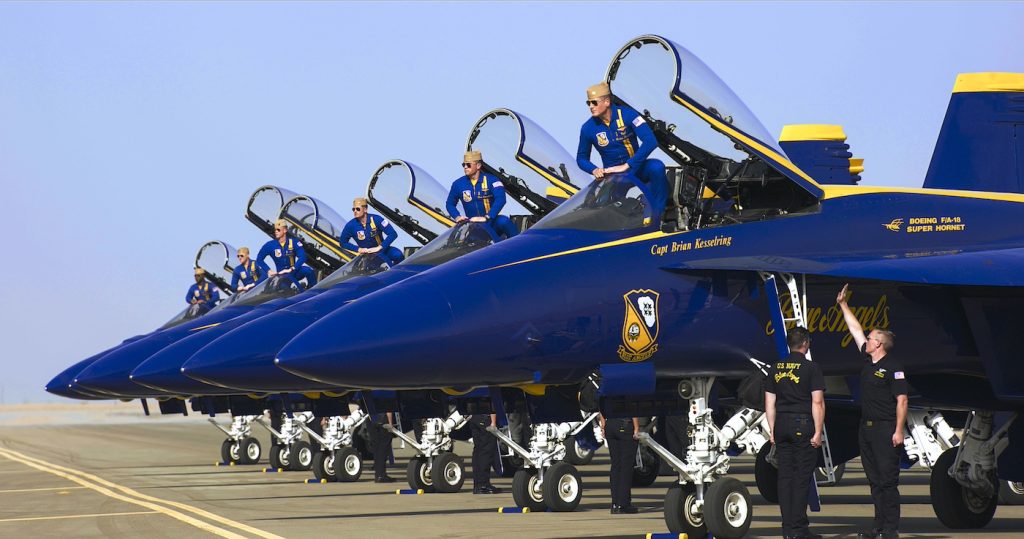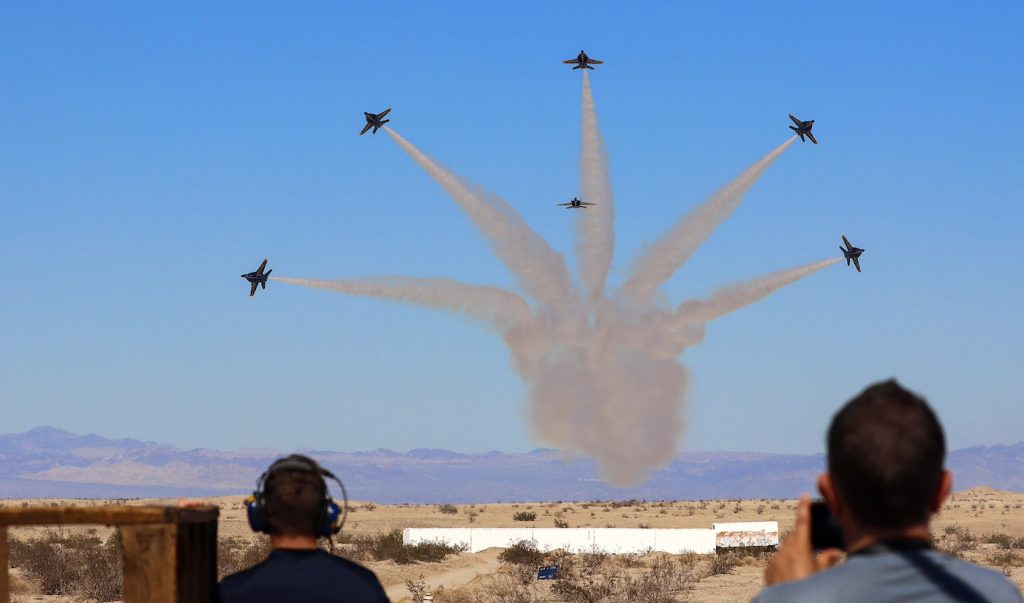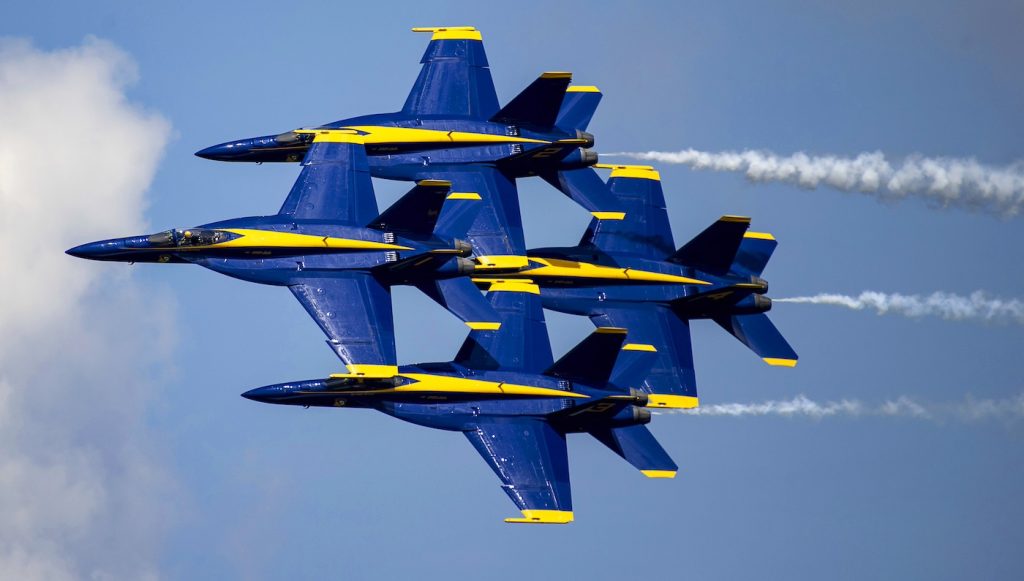Chasing Precision and Perfection with Aerial DPs on “The Blue Angels” – Part 1
Every year since the Blue Angels were established in 1946, crowds of all ages have oohed and aahed at airshows from Brunswick, Maine to Huntington Beach, California, as the United States Navy’s precision flight demonstration team performs intoxicatingly vertiginous aerial maneuvers in the skies. With six F/A-18 Super Hornet fighter jets flying a mere 12-18 inches apart at 400-600mph, the only way to capture every hypersonic swoop and stomach-churning roll on camera up close—and safely—for the Amazon MGM feature documentary was to have a former Blue Angel in the aerial cinematography team. “I was in the right place at the right time,” says LCDR [Lieutenant Commander] Lance “Bubb” Benson, who was an F/A-18 instructor prior to two tours with the squadron, flying the #3 and #4 jets in the Diamond during his first stint and then returning in 2021 to fly the #6 jet as the Opposing Solo. “I had the unique experience from both sides of the demonstration to safely put the helicopter and the chase jet up in the air in the right spots to capture what we needed.”
To take audiences into the inner sanctum of the team, director Paul Crowder was given unprecedented access during the 2022 season, when the demo team/squadron (all active-duty naval and Marine Corps aviators from the fleet) was led by Captain Brian Kesserling, who flew the #1 jet as the Flight Leader (traditionally called “Boss”). Following their grueling three-month winter training in El Centro, California, to the eight-month show season across 30 locations, the film provides a glimpse of the rigorous selection process for new members and details how the 130-plus maintenance and logistics crew keeps the show moving.

Not only was Benson integral in the planning process, but he also flew the “chase jet,” a seventh F-18, alongside the demo team to capture some of the propulsive footage. “99 times out of 100, there are only six jets airborne. But every once in a while, on a Thursday or Friday, you’ll see a seventh jet chasing them to get video footage,” he explains. On several occasions, he flew a two-seater F-18 with aerial cinematographer Michael FitzMaurice in the backseat holding on to a Sony FX3 handheld camera as they followed the squadron through all the maneuvers, sometimes pulling over 7gs in-flight (seven times the force of gravity). “Some of the best shots we captured were when we’re inverted over the top of the team as they’re going on the roll,” FitzMaurice shares, adding, “I had the camera above my head looking through the top of the canopy. That’s all great until you start pulling some gs. Your hands are above your head, holding a three-pound camera, which suddenly becomes nine pounds, 12 pounds, and you’re trying to hold that in position. It was tough but a lot of fun!”
For the first time in Blue Angels history, a civilian aircraft was allowed to fly inside the performance airspace, called “the box,” with aerial coordinator Kevin LaRosa II flying the Airbus H125 helicopter and FitzMaurice shooting on an IMAX-certified Sony Venice 2 camera with the Angenieux 12:1 lens. “This was one of the rare projects where the subject aircraft wasn’t at our direction, we couldn’t tell them what to do or how many times we wanted to do it. We couldn’t change their flight profile because it would be negative training for them, which is a safety hazard,” LaRosa reveals of the challenge when there is no option for a second take. “We had to integrate our helicopter around their normal demonstration without creating any safety issues. So, we studied their performances a lot more than normal so that we could be very proficient, get the best shots, and not get in their way.”
The trio only had about ten shooting days with the demo team between a couple of weeks in Pensacola and another week with some bad weather in San Francisco. FitzMaurice estimates that 90% of the aerial capture exterior of the jet came from the helicopter. Every flight with the squadron was “43 minutes of the most high-energy flying that we’ve ever done,” says LaRosa. “There’s no second take – you get one take at each event that we flew. It’s 43 minutes of maxing out the performance of the helicopter, gimbal, and camera. But it feels like it goes by in five minutes! By the time you land, you’re mentally and physically exhausted.”

The meticulous planning started three months before they went up in the air, as Fitzmaurice and LaRosa studied GPS ground tracks provided by the Blue Angels and video footage of past demonstrations. “We watched the maneuvers and visualized the best angles to capture them. Lance knows a lot about where their outs were and the safest places for us to be,” recalls FitzMaurice. “So, we worked through it with him and took it to the whole Blue Angels team. By the time we were actually in the air with the helicopter, where we put ourselves was exactly where we said we’d be on a map.” Benson agrees that their exhaustive planning really paid off. Introducing a civilian aircraft flying at 100mph in the midst of six F-18s screaming by at 400-600 mph certainly elevated the risk. “As a former demo pilot, my biggest concern was safety,” he says.

“The Blue Angels show becomes safer during each season because it’s so repeatable: it’s the same show nearly every day. We change it for weather or things in the area that we can’t control, but generally, there are very few distractions. In this case, we’re interjecting another jet [into the mix]. Jets #1, #4, #5, and #6 were probably going to see the helicopter quite often, but #2 and #3 were flying off of Boss [Kesserling] 99% of the time, so the odds of them seeing us were pretty low,” Benson explains. Initially, he was concerned about the maneuverability of the helicopter in that high-speed environment. “As the solos are coming in on the ‘Knife Edge Pass,’ they’re not used to seeing a helicopter sitting there barely outside their wing set, waiting to capture that moment. But we mitigated the risks by briefing the team every morning on where to expect us. It all worked out very well but took a lot of planning.”
During the demo, there are only 45-60 seconds between each element/maneuver. “Since the helicopter flies at much lower speeds, if you aren’t already moving it as a Blue Angels maneuver goes by to reposition it, you’re only out might be to go down to the ground and get out of the way. So, we had very limited time to capture the images and move to a new position and be ready as the next maneuver came,” Benson explains. It was my job to make sure we were getting to the right position to keep us all safe. Before each flight, Kevin, Michael, myself, and the team would look at the next day’s flight profile and the shots we’re looking for, where and when we could put the helicopter safely, and when to get out of the way.”
Check back tomorrow to find out why the significant discrepancy between the airspeeds turned out to be an advantage and how the documentary benefited from Top Gun: Maverick.
For more on Amazon Prime Video, check out these stories:
Nicolas Cage set to Star in Live-Action Spider-Man Noir Series
“Blade Runner 2099” Adds Michelle Yeoh to Cast in Leading Role
Featured image: “Blue Angels.” Courtesy Amazon MGM.




